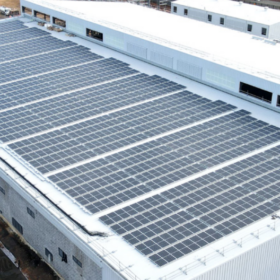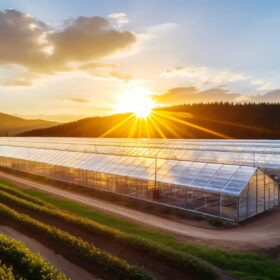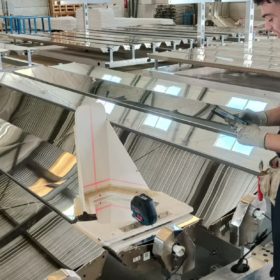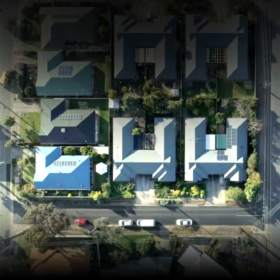Top News
Hunter Valley hydrogen hub gets $432 million kick-start

Building contractor launches sustainable practice blueprint

$20 million greenhouse to reap solar innovation for agrivoltaic sector growth
Out now - pv magazine Global June edition

Novel green hydrogen pilot plant wins $2.7 million grant

AGL acquires South Australia virtual power plant from Tesla
Perovskite solar cell efficiency improves with micro-concentrators
Ausgrid accelerates vehicle-to-grid revolution in New South Wales
Clean energy research nabs over $2.6 million in grants
Press Releases
Evnex bargain-hunts for lowest charging prices with Amber integration
Researchers use lightning to make ammonia out of thin air
Ball Australia’s growing vision for energy efficient future
Mildura’s renewable energy future: Council calls for REZ designation
Opinion & Analysis
Featured
What does Australia’s new battery rebate mean for V2G technology?
The solar battery rebate scheme must not become ‘Pink Batts 2.0’
The Albanese Government’s $2.3 billion solar battery rebate scheme is one of the most exciting developments Australia’s energy sector has seen in years but if we don’t get the rollout right from day one, we risk undermining everything this scheme stands for and repeating the disastrous mistakes of the Pink Batts program.
The KPIs that quietly drive battery market share in Australia
The Australian residential battery market is heating up — and beneath the surface, a new set of performance metrics is emerging as decisive for brand success. While some manufacturers chase short-term growth by dropping prices, the real battle for sustainable market share is being fought on deeper metrics: share of installer adoption, share of installer portfolio, and customer loyalty.
Bringing back-contact to the foreground
Solar manufacturers are pursuing the next-generation crystalline silicon (c-Si) PV cell technology. Back-contact (xBC) technologies including TOPCon back-contact (TBC), HJT back-contact (HBC), and HJT TOPCon back-contact (HTBC) have emerged as leading candidates, attracting attention for their superior conversion efficiency and aesthetic module designs.
How grant system is locking millions away from those doing heavy lifting
Australia’s grant system is working exactly as designed. And that’s the problem. Right now, if you’re a small business or a not-for-profit, there’s likely a funding stream available to help you test an idea, buy equipment or build capability. If you’re a multinational or a university, there’s even more. But if you sit in the middle, a commercially viable, medium-sized business with proven success, and the capacity to deliver major outcomes, you’re often left with nothing. This isn’t sour grapes, it’s missed opportunities.
Why a big battery is cheaper than small with federal battery rebate
The federal government has announced a national battery rebate scheme that comes into effect on July 1, although many eligible installations have already taken place.
Markets & Policy
Featured
$9.4 billion vertically integrated battery plant breaks ground
VIN West landholder engagement stepped up as project end date shifts two years
Transmission Company Victoria has advised landholders impacted by the VNI West transmission project, the expected completion date is shifting from 2028 to late 2030, while landholder engagement programs are expanding beyond the boundaries of easement.
Horizon seeks federal approval for Derby solar and storage plans
Western Australian regional energy provider Horizon Power is seeking a federal green tick for a 21 MW solar-plus-battery storage project designed to help power the coastal town of Derby in the state’s Kimberly region.
Malaysian giant teams with Tasmanian landowners on 1.2 GW portfolio
Malaysian infrastructure giant Gamuda is taking the next step in its Australian growth plans, partnering with landowners in central Tasmania to co-develop a 1.2 GW portfolio of large-scale renewable energy generation and storage projects.
Atmos reaches financial close on 400 MWh battery project
Atmos Renewables is gearing up to start building its first standalone battery energy storage project in Western Australia after reaching financial close on the 100 MW / 400 MWh system to be built near Merredin in the state’s central Wheatbelt region.
Robotics company lands federal funds to scale up solar construction
Robotics company Luminous has secured almost $5 million in federal government funding to support the deployment of a fleet of AI-powered robots designed to accelerate the construction of utility-scale solar farms.
Installations
Featured
Risen hits 740 W average for mass-produced HJT module
Quinbrook brings largest UK solar plant online
Australian-owned developer Quinbrook Infrastructure Partners has announced that its 373 MW Cleve Hill Solar Park – the largest solar plant in the United Kingdom to date – is now exporting 100% of its capacity to the grid. Under construction, co-located energy storage is to come online later.
Report reveals renewable energy potential of Aboriginal land holdings in NSW
A new report highlights the potential for Aboriginal land holdings in New South Wales to accelerate the state’s renewable energy transition, suggesting that strategic support could unlock more than 11 GW of solar energy or 1.6 GW of wind energy.
NSW green bank backs energy projects with $1 billion purse
The New South Wales government’s new green bank is now open for business with an initial $1 billion In funding available to accelerate key energy projects to support the state’s shift from coal-fired power generation to renewables.
How albedo interacts with rooftop PV system patterns
Researchers have simulated 160 cases of PV rooftop installation in southern and northern Italy. Among changing parameters were size and type of the panels, as well as their roof cover rate. The considered albedos were 20%, 40%, 60%, and 80%, representing different types of roof materials.
Trinasolar targeting ‘high-value’ markets
Yang Bao, Trinasolar’s president of global sales and marketing, recently spoke with pv magazine about the company’s strategy for the solar and energy storage business.
Technology
Featured
Tongwei achieves 91.7% bifaciality factor for 722 W TOPCon solar module
MoorPower takes next step on commercialisation journey
Australian wave power technology company Carnegie Clean Energy has secured new funding to advance the design of a commercial wave energy generation system for offshore applications, starting with the moored vessels used in the aquaculture sector.
Project to test floating PV on farm dams to save water, generate electricity
The feasibility of deploying floating solar systems on farm-based water storages to optimise water retention and generate renewable energy that could serve as an alternative income stream for landholders will be investigated as part of an Australian-first research project.
Australian battery maker targets military-related applications
Queensland battery technology developer Li-S Energy has signed a supply and testing agreement with an unnamed defence technology company, targeting integration of lithium-sulfur battery solutions into advanced military and security systems.
SERIS achieves world record efficiency of 26.7% for perovskite-organic tandem solar cell
The tandem device is based on a bottom organic cell that can achieve a power conversion efficiency of 17.9% and a high short-circuit current density of 28.60 mA cm2. Furthermore, it uses a top perovskite solar cell with an open-circuit voltage of 1.37 V and a fill factor of 85.5%.
Policy shifts needed to unlock existing transmission network capacity
Neara co-founder Jack Curtis says the opportunity to boost capacity of existing transmission networks is possible with smarter grid solutions and derisk reliance on new transmission projects facing potential delays.
Manufacturing
Featured
Brisbane battery manufacturer makes moves into US market
Sinovoltaics tracks 86.5 GW of module output capacity for Southeast Asia
PV module manufacturing capacity in Southeast Asia has reached 86.5 GW across 61 active sites, according to Hong Kong-based quality assurance firm Sinovoltaics. The figures come from the company’s latest “Southeast Asia Solar Supply Chain Map” report.
New South Wales councils not waiting for government to mandate electrification
With just 54 months until New South Wales reaches its 2030 50% emissions reduction target, five councils are taking matters into their own hands to mandate the electrification of all new buildings, except industrial.
The best tilt angle to improve PV system performance on low-income housing
Researchers have demonstrated that the theoretical optimal tilt for rooftop solar energy production in low-cost buildings in Nigeria is approximately 5.67°. Their modeling suggests to adopt south-facing roofs for PV generation in the southern hemisphere.
JinkoSolar achieves world record efficiency of 27.02% for TOPCon solar cell
The Chinese manufacturer said the result was certified by China’s National Photovoltaic Industry Measurement and Testing Center (NPVM).
Australian cell manufacturer launches first module series
Australian solar cell developer Halocell Energy has launched its first perovskite-based product line with the flexible Ambient Modules series purpose-built for low-light conditions.
Energy Storage
Featured
Alinta gives construction go-ahead for 250 MW battery project in South Australia
Ace Power’s 8 GWh battery project clears federal hurdle
A battery energy storage system of up to 1 GW and 8 GWh capacity has been given the green light for northern New South Wales after securing environmental approval from the federal government.
Discounts don’t buy home battery trust in rebate landscape: study
A new study out of Curtin University in Perth has found that despite growing affordability from government rebates, Australian households hesitate to adopt home batteries due to significant non-financial barriers.
Future NEM reliability forecast to flounder without investment increase
AEMO forecasts potential reliability gaps as early as 2026-27 in South Australia and 2027-28 in New South Wales, based on current committed and anticipated projects, but new investment would narrow the risks.
Western Australia warns solar traders against bogus battery rebate activity
Western Australia’s solar industry is on notice after a trader unlawfully used the state government logo and falsely claimed WA Battery Scheme registrations are open in a deliberate act to mislead consumers.
Smart data unlocks solutions for network challenges
As Australia’s distribution network service providers grapple with challenges sparked by the rise of distributed energy resources, EA Technology says leveraging insights from grid-edge intelligence can unleash the full potential of their networks.


